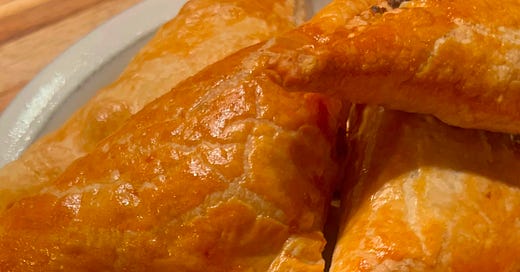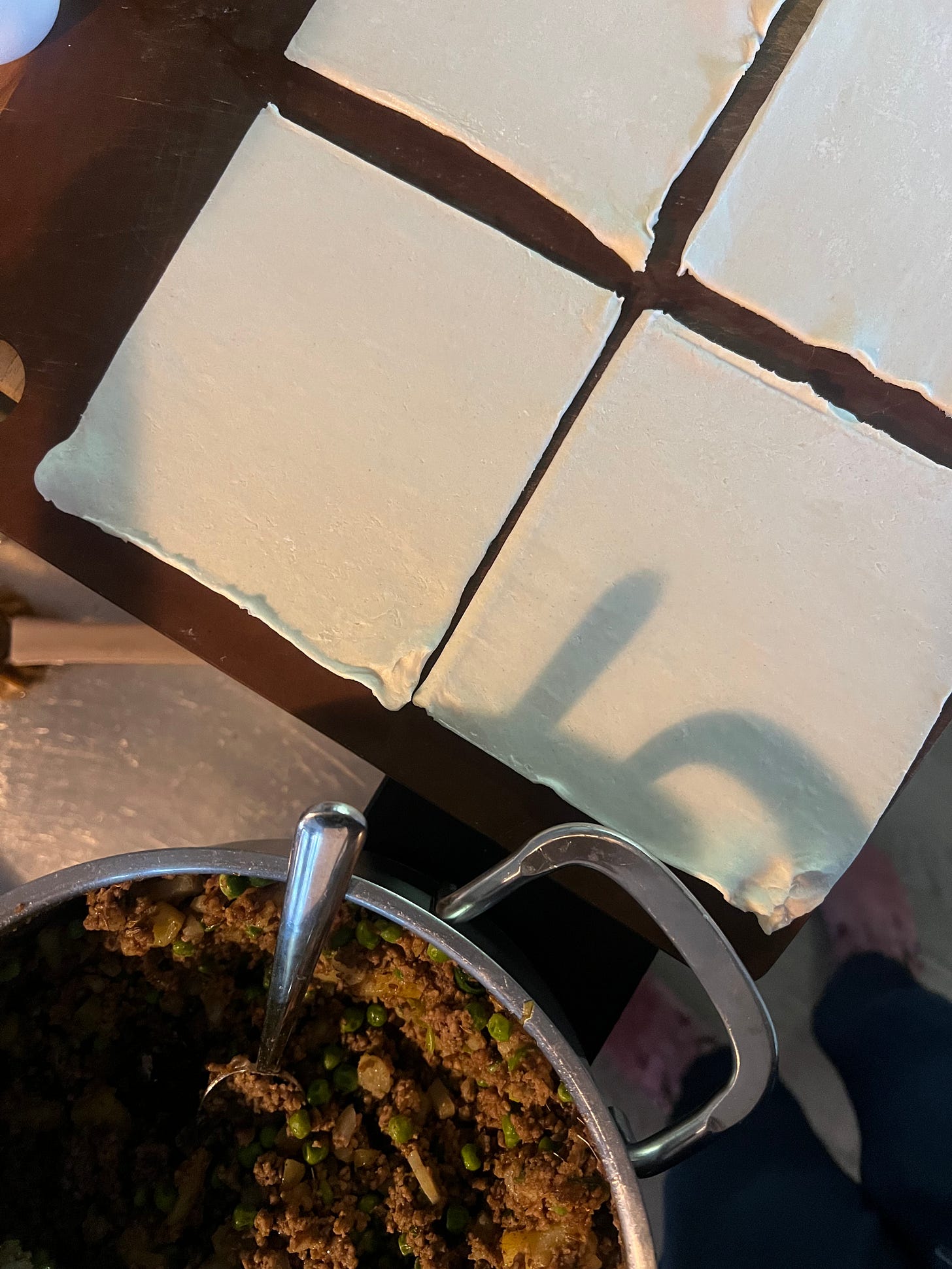My earliest memories of Ramadan always take me back to that cosy pocket of time between the late afternoon and sunset. Everyone is home, slowly getting ready to eat together. Siblings setting the table, the Persian Gulf’s dusk light bouncing off the water jug. I'm in the kitchen on my tip toes, taking in every step of the process. The flour-dusted countertops, the rolling pin, the slow-thawed block of puff pastry, the pot of spiced lamb mince filling, a brush, a knife, a fork, a whisked egg. The comforting low hum of the oven, filling the room with a buttery pastry scent from the batch already being cooked. As I grew older, and taller, I earned my place on the assembly line, graduating from spectator to sous-chef under Mum's watchful eye.
So, naturally, when I moved away, I carried on both traditions, making eccles cakes for nostalgia and samosas as a Ramadan staple. My first Ramadan away from home was an entire continent away in London. The weekend before the first fast, we gathered in my older cousin's flat just behind St. Paul's Catherdral. Being the youngest and only girl, I found myself directing an assembly line of grown men, shuffling trays and pastry between the living room and narrow kitchen. It's the closest I've ever felt to a boss lady in my family dynamics. We made over 200 samosas that day, ready to be batched, bagged and disributed amongst our freezers to last the month. I've migrated countries three times since, weaving myself into new cultures and cuisines. Every Ramadan, these samosas remained a constant in my shared or solo kitchens. I perfected the recipe to a point that it felt like I'd achieved time travel.
Growing up, my mum had a second Ramadan tradition. With the leftover pastry dough, she would mix raisins, sugar, and soft butter to make eccles cakes, a traditional pastry born in Lancashire. It was a taste of her childhood in the north of England, a small sweet indulgence among the savoury preparations. When I left home, I missed the taste, so began to do the same as a form of feeding my nostalgia and connection between continents. What I didn’t realise was that this act of nostalgia would lead to a revelation generations in the making.
With the rise of anti-fried food discourse online, I felt a little smug about our baked samosa tradition that had been going for generations. It got me thinking—where did my mum even learn to make them this way? I dropped the question into our family group chat.
"Mum, how many generations does this samosa receipe it go back exactly? Did your Ammi (mother) learnt it from her Ammi?"
"The samosa was due to your aunt making eccles cakes in school with puff pastry. So we modified it with the samosa filling to make a samosa. Lots of people call them patties"
Wait. What?
For years, I thought our samosas were an age-old tradition, passed down through generations. A piece of heritage from distant lands. My romantic journey of this recipe was suddenly replaced with the byproduct of a school assignment. A tweak to a very British pastry. In turns out the origin story of my family's samosas was a happy accident born from resourcefulness and leftover dough.
My sibling described it as a revelation. That evening, as I bit through the flaky layers of pastry, reaching the flavourful soft lamb mince, potatoes and peas, my mind was racing around the migration journey of my favourite dishes. The story invited my imagination to relive part of my Mum's childhood. The adaptation. The emergence of subculture. This entire time I'd always stopped exploring the origin story of a recipe at one generation. Not stopped to ask "but where did they learn it from?".
We often talk about migration in terms of people, tracing lineages and journeys across borders. But what about food? What about the way dishes adapt and morph in new lands?
A few years ago, I was visiting my paternal relatives in Uganda when the friend we were staying with excitedly insisted, “You have to try a Rolex.”
A Rolex? I asked my Kampalan family about it later.
“Oh, the locals call it that here - it’s basically rolled eggs in a roti. Say it fast enough, and it becomes a Rolex. It’s our anda (egg)-paratha. They have recreated it here” my uncle explained, as though he'd told the story a thousand times.
South Asian migration over the last century has lead to omelette paratha popping up from beach cafeteria's on the Arabian Gulf coast to most street corners in this pocket of East Africa; each a localised version with it's own food migration and subculture iteration.
Food origin stories can be political minefield, if you let it. Just as many people bristle at the question, "Where are you from?", I give the same grace to dishes. In my world, samosas originated in the north of England and Rolexes originated in India. My samosa answer was entirely different most of my life, until my Mum's truth bomb in the family group chat this year. In the 1960s, before the adaptation to puff pastry, that samosa story was different too. Others might have completely different answers to the same question, and that's okay.
The beauty of humanity is that we reinvent, we adapt, we carry flavours of home into new places and new generations, whether we realise it or not. As Mark Twain put it:
“There is no such thing as a new idea. It is impossible. We simply take a lot of old ideas and put them into a sort of mental kaleidoscope. We give them a turn and they make new and curious combinations. We keep on turning and making new combinations indefinitely; but they are the same old pieces of coloured glass that have been in use through all the ages.”
This Ramadan, an otherwise wandering thought dropped in a group chat, reminded me that dishes, like people, are constantly evolving. I want to embrace that, tracing the origin story as far as I can can, hoping to continue to find plot twists in the most unexpected places, even if it's in our own kitchens.






